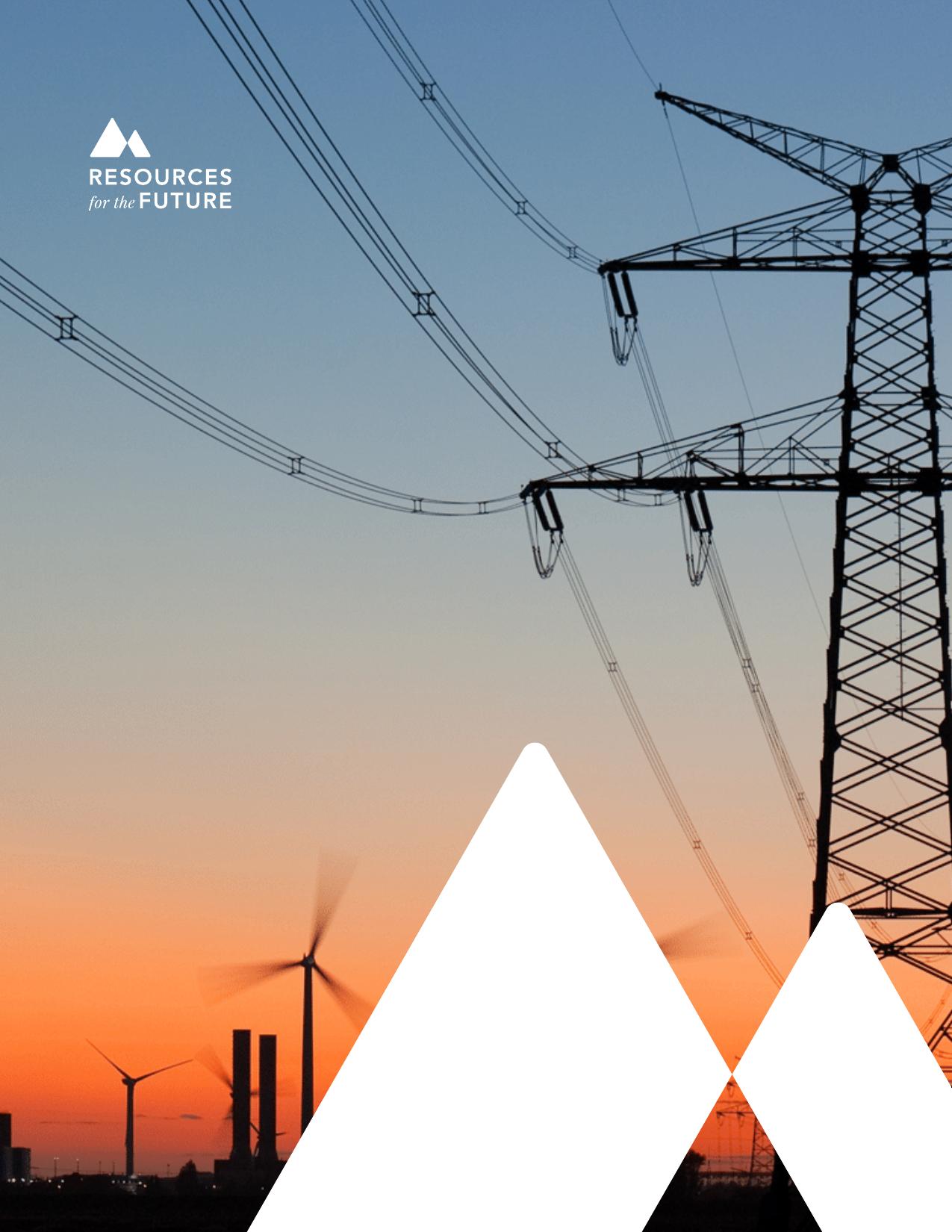ExpandingthePossibilities:WhenandWhereCanGrid-EnhancingTechnologies,DistributedEnergyResources,andMicrogridsSupporttheGridoftheFuture?SrishtiSlaria,MollyRobertson,andKarenPalmerReport23-13September2023ExpandingthePossibilities:WhenandWhereCanGETS,DERs,andMicrogridsSupporttheGridoftheFuture?AAbouttheAuthorsSrishtiSlariaisaneconomicsPhDcandidateattheUniversityofKansasandwasasummer2023internatResourcesfortheFuture(RFF).Hercurrentresearchseekstoexploretheimpactsofclimatechangeandnaturalresourcescarcity,andthepolicyimplicationsofthefindings.Withinenergyeconomics,Slaria’sresearchfocusesontheUSelectricitysector.Intheenvironmentalrealm,shehasstudiedhouseholdwaterconservation.Inthefuture,sheisespeciallyinterestedinapplyingbehavioraltheoriesandtoolstoimproveconsumerdecision-makingwithregardtoenergyandenvironmentalbehaviorssuchasconservation,recycling,foodwaste,andtransportation,bothintheUSandinternationally.MollyRobertsonisaresearchassociateatRFFworkingontopicsrelatedtotheelectricpowersector,includinggriddecarbonization,electrification,andelectricitymarketdesign.ShehasalsocontributedtoRFF’sgrowingworkonequitablecommunitytransitionandenvironmentaljustice.Sheholdsamaster’sinpublicpolicyfromtheUniversityofMichigan’sFordSchool.KarenPalmerisaseniorfellowatRFFandanexpertontheeconomicsofenvironmental,climateandpublicutilityregulationoftheelectricpowersector.Herworkseekstoimprovethedesignofenvironmentalandtechnologyregulationsinthesectorandthedevelopmentofnewinstitutionstohelpguidetheongoingtransitionoftheelectricitysector.Totheseends,sheexploresclimatepolicydesign,analyzesefficientwaystopromoteuseofrenewableandothercleansourcesofelectricity,andinvestigatesnewmarketdesigns,newapproachestoelectricitypricingandregulatoryreformstopavethewayforlong-termdecarbonizationofelectricitysupplyandelectrificationoftheenergyeconomy.ResourcesfortheFutureiAboutRFFResourcesfortheFuture(RFF)isanindependent,nonprofitresearchinstitutioninWashington,DC.Itsmissionistoimproveenvironmental,energy,andnaturalresourcedecisionsthroughimpartialeconomicresearchandpolicyengagement.RFFiscommittedtobeingthemostwidelytrustedsourceofresearchinsightsandpolicysolutionsleadingtoahealthyenvironmentandathrivingeconomy.TheviewsexpressedherearethoseoftheindividualauthorsandmaydifferfromthoseofotherRFFexperts,itsofficers,oritsdirectors.SharingOurWorkOurworkisavailableforsharingandadaptationunderanAttribution-NonCommercial-NoDerivatives4.0International(CCBY-NC-ND4.0)license.Youcancopyandredistributeourmaterialinanymediumorformat;youmustgiveappropriatecredit,providealinktothelicense,andindicateifchangesweremade,andyoumaynotapplyadditionalrestrictions.Youmaydosoinanyreasonablemanner,butnotinanywaythatsuggeststhelicensorendorsesyouoryouruse.Youmaynotusethematerialforcommercialpurposes.Ifyouremix,transform,orbuilduponthematerial,youmaynotdistributethemodifiedmaterial.Formoreinformation,visithttps://creativecommons.org/licenses/by-nc-nd/4.0/.ExpandingthePossibilities:WhenandWhereCanGETS,DERs,andMicrogridsSupporttheGridoftheFuture?iiContents1.Introduction�12.GridNecessities�23.Grid-EnhancingTechnologies�23.1.DynamicLineRating�23.2.FlexibleAlternatingCurrentTransmissionSystem�53.3.TopologyOptimization�73.4.KeyFindingsonGETs�104.DistributedEnergyResources�104.1.Fuel-BasedDistributedGeneration�114.2.Emissions-FreeDistributedGeneration�114.3.BatteryEnergyStorage�134.4.DemandResponseandVirtualPowerPlants�134.5.TakeawaysonDistributedEnergyResources�155.Microgrids�165.1.TakeawaysonMicrogrids�206.Conclusion�207.References�22ResourcesfortheFutureiii1.IntroductionAchievingtheambitiousdecarbonizationgoalsestablishedbytheBidenadministration,100percentcleanelectricityby2035andanet-zeroemissionseconomyby2050,requiressubstantiallyincreasingtheshareofcleanandrenewableenergyresourcesintheelectricitygenerationmix.Toreachthesedecarbonizationtargetscost-effectively,renewablepowerwillneedtogrowtomultiplesofcurrentlevels.Thetransmissionsystemisnotequippedtohandletheanticipatedsubstantialincreaseinpowerflows;itslackofcapacityandavailabilityleadstogridcongestion,whichcauseshigherenergypricesandcurtailsrenewables.Moreover,withtheanticipatedelectrificationoftheeconomyleadingtolargeincreasesinfuturedemand,theburdenonthepowergridiseverincreasing.AreportfromtheREPEATprojectestimatesthattotakefulladvantageofthesubsidiesofferedintheInflationReductionAct(IRA),transmissioncapacitymustgrowbyabout2.3percentperyear,morethandoubletherateofthepast10years(Jenkinsetal.2022).Nevertheless,gettingnewprojectsbuiltcantakeoveradecadeduetothecomplexitiesinvolvedintheirplanning,siting,andpermitting.Stateandfederalpolicymakershaveacknowledgedthischallengeandtakenstepstosupportthebuildoutofnewtransmission.TheInfrastructureInvestmentandJobsAct(IIJA)andIRAcarvedoutsupportfortransmissionexpansion,allocating$12.5billionand$5billion,respectively.Furthermore,theBidenadministrationrecentlyannouncedplanstostreamlinethefederalpermittingprocessfortransmissionlinesthroughtheDepartmentofEnergy(DOE)tofacilitatebuildout.Nonetheless,expertsarestillskepticalthatwecanbuildenoughnewtransmissionintimetosupporttheshiftinggenerationmixandincreasingelectrificationtomeetclimatetargets.However,buildingnewlinesisnottheonlywaytobolsterresilience,reliability,andaffordability.Severaldifferenttypesofinvestmentscandeliversimilaroutcomes.Grid-enhancingtechnologiescanincreasethecapacityofexistinglines,distributedenergyresourcescanspreadoutgenerationresourcessotheyareclosertoloadcenters,andmicrogridscanuseon-sitepowergenerationtosupportpocketsofloadandinsulatecampusesorcommunitiesfromissuesonthebroadergrid.Thesesolutionscandeliverbenefits,buteachisbestsuitedtoaspecificsetofcircumstancesandfacesitsowntechnicalandregulatorybarrierstoimplementation.Thisreportsurveystheliteratureondifferenttypesofgridsolutions.Wediscusshowthetechnologieswork,inwhatcircumstancestheymayactassubstitutesfortransmissionexpansion,evidenceoftheirimpact,andchallenges(bothtechnicalandregulatory)inimplementingthem.Newlineswillundoubtedlybeanimportantpieceoftheenergytransition,butexploringtheseadditionaltypesofinvestmentscanhelpusunderstandwhereandwhenlower-costandmorerapidlydeployedalternativescanprovidesolutionstosomeofourtransmissionwoes.ExpandingthePossibilities:WhenandWhereCanGETS,DERs,andMicrogridsSupporttheGridoftheFuture?12.GridNecessitiesTheneedfornewtransmissionisdrivenbytwocoregoalsofgridoperators:reliabilityandaffordability.Newlinescanincreasereliabilitybyconnectingmoregenerationresourcestothegridandlinkingentireregionswithdiversetypesofresources.Forexample,alinethatconnectsaregionwithamplesolarpowertoonewithamplewindpowercanhelpextendpoweravailabilitywhenoneofthoseresourcesisunavailable.Newtransmissioncanalsodeliveronaffordability,especiallyinderegulatedregionswithcompetitivegeneration.Byincreasingthenumberofgeneratorswithaccesstoamarket,load-servingentitieshaveagreateropportunitytofindlow-costpowersourcesasgreatercompetitionleadstolowerprices.Foraninvestmenttobeconsideredatransmission“substitute”inacertainsituation,itmustdeliverincreasedreliabilityandaffordabilitytotheregionofinterest.Insomesituations,theinvestmentwouldnotdisplacetheneedfornewtransmissionbutcouldpostponeit.Theseinvestmentscandeliverbenefitsinthenearterm,somethingthatischallengingwithnewlines.Theinvestmentsweexploreimprovereliabilityandaffordabilityinthefollowingways:(1)relievinglinecongestion,(2)connectinglow-costresources(especiallyrenewables)toload,(3)minimizingenergylosses,and(4)increasingflexibilityandresponsespeedtohandleuncertaintiesinrealtime.Wediscussthreebroadcategoriesofinvestmentsthatcan,incertainsituations,substitutefornewtransmission:grid-enhancingtechnologies(GETs)arehardwareandsoftwarethatimprovethegrid’sefficiencyandreliability;distributedenergyresources(DERs)aresmall-scale,modularresourcesandtechnologiesthatgenerateandsupplyelectricityatorneartheplaceofuse;andmicrogridsarelocalizedenergysystemsthatcangenerate,store,anddistributeelectricityautonomouslytoconnectedfacilities,withorwithoutbeingconnectedtothetraditional,high-voltagegrid.3.Grid-EnhancingTechnologiesGETsenhancethecapacityofhigh-voltagelinesandreducecongestion.WeexplorethevalueofthreemaintypesofGETs—dynamiclinerating(DLR),flexiblealternatingcurrenttransmissionsystem(FACTS),andtopologyoptimization(TO).Werevieweachtechnologyanditsspecificbenefitsandlimitations.3.1.DynamicLineRatingThemaximumcurrent-carryingcapacityofoverheadlines(called“ampacity”)dependsontemperature,linesag/tension,theconstructionmaterial,andweather(IRENA2020).Traditionally,transmissionsystemoperators(TSOs)haveusedstaticlineratings(SLRs)thatrelyonasetofconservativeweathermeasurements,suchaslowwindspeed,highsolarradiation,andhightemperature,topredetermineafixedlevelofampacity.Theseratingsoftenvarybyseason,referredtoas“seasonalstaticratings”ResourcesfortheFuture2(Tsuchidaetal.2021).Incontrast,DLRsystemsactivelyvarylineratings,basedonreal-timemonitoringofenvironmentalfactors,suchasambienttemperature,windspeedanddirection,andsunlight(IRENA2020).Ambientadjustedratings(AARs)appearinsomeregionsandlieinbetweenSLRsandDLRsindynamicity.Thesedevicesuseline-specificdataandambientairtemperaturedatabutdonotmonitorchangesinrealtimeorconsidersolarradiation,wind,orotherfactorsthatproducemoreaccuratelineratingsinclosetorealtime(Figure1;NewYorkPowerAuthorityn.d.).RecentFERCOrders881and881arequiretransmissionproviderstoadoptAARsfortransmissionlinesbyJulyof2025(Thappetaobula2023).Figure1.DifferentTypesofLineRatingsSource:USDOE,2020,8.DLRsystemsaimtooptimizelineuse,therebyreducingcongestionandimprovingthetransfercapabilityofindividuallines.Togiveacommontransitanalogy,SLRislikealwayskeepingspeedlimitslowtoaccommodaterainyandsnowyroadconditions,whereasDLRislikeadjustingthespeedlimitinrealtimebasedondifferentweatherandroadconditions(Mendelletal.2022;Tsuchidaetal.2021).Intermsofphysicalinfrastructure,aDLRsystemtypicallyincludessensorsonornearlines,informationrelayingcommunicationandanalyticalsystemsthatprocessDLRdata,controlsystems,andoperatorswhomakedecisionsaboutlineusebasedontheDLRinformation.Figure2depictsaDLRsystem(USDOE2020).ExpandingthePossibilities:WhenandWhereCanGETS,DERs,andMicrogridsSupporttheGridoftheFuture?3Figure2.AConceptualDLRSystemSource:USDOE,2020,7.DLRsystemscouldoffermanybenefitstothegrid.AjointstudybyDOEandONCORfoundthatDLRscanincreasetransfercapabilityoflinesby5–25percentrelativetoSLR,whichreducescongestioncostsandrenewablescurtailment(Tsuchidaetal.2021).Capacityincreasesareespeciallypronouncedforwindpowerintegrationbecausehighwindssimultaneouslygeneratepowerandcoolthelinesnearby,increasingtheirtransfercapacity(USDOE2020).TwocasestudiesinPennsylvaniaandUpstateNewYork(Tsuchidaetal.2023)demonstratehowDLRsoncongestedlineswouldavoid$23.5millioninestimatedannualcongestioncostsandreducewindandsolarcurtailmentbymorethan350MW.DLRdevicesalsohavealowercostandfasterinstallationcomparedtoreconductoringandrebuildinglines,whichcantakeseveralyearsandrequireextendedlineoutages.APJMstudyshowedthatupgradingalinebetweenMichiganandIllinoiswithDLRtechnologyfor$500,000couldsave$4millioninannualcongestioncosts,whereasthetraditionalsolutioncouldcost$22–176million(USDOE2020).Furthermore,DLRdevicescanbedeployedandrelocatedquickly,providingvaluableflexibilitytotransmissionowners(Tsuchidaetal.2023).DLRtechnologiesalsoprotecttheequipmentfromsafetyhazardsbyincreasingsituationalawareness.Forinstance,real-timemonitoringcaninformoperatorswhendynamicratingsfallbelowstaticratingsandlinesareatrisk,possibleonadaywithextremeheatandnowind.Regulardataandfeedbackonlineshelptrackthehealthofthesystem,detectanyirregularities,andinformfutureforecastsfortransmissionandgenerationplanning(USDOE2020).DLRscanalsoenhanceresiliencewhenextremeweathereventscorrelatewithincreasedline-carryingcapabilities,suchasduringacoldsnapwhendemandforheatingisabnormallyhighbutlinescancarrymorecurrent(USDOE2020).AlthoughDLRsystemshavemultiplebenefits,theyalsohavelimitations.First,thedeviceispronetomeasurementandmodelingerrorsthatcanresultfromimproperlycalibratedsensors,errorsinweatherforecastinganddatacollection,andsparsesensorResourcesfortheFuture4deployment(USDOE2020).Furthermore,DLRsareonlyeffectiveonheavilyloadedlines.TwoDLRprojectsunderDOE’sSmartGridDemonstrationProgramfoundthatthesensorscannotgatherprecisedataforlightlyloadedlines(WangandPinter2014).UsingDLRsonheavilytraffickedlinesandincludingconfidenceintervalsinDLRestimatescanmitigatetheimpactoferrors.AlthoughISOsandRTOscanleverageAARwithintheirexistingcontrolsystems,incorporatingDLRmayrequirechangingmarketoperationsorinvestinginnewcontrolsystems,whichcanbeexpensive.TheincrementalbenefitsofDLRbeyondAARmaybesmallincertainareaswherewindspeedsdonotvarysignificantly.DLRprojectsmayfaceanotherdisadvantagefromtheincentivescreatedbythestructureofutilityrateregulation.Specifically,DLRsarenotcapitalintensiveandthuscontributelittletoautility’sabilitytoearnarateofreturn,unlikeinvestmentsinnewlinesandtowers.Thus,owners’currentbusinessmodelstendtofavorcapital-intensiveapproaches.Overall,DLRisalow-costtechnologytoincreaseexistinglinecapacityandprovidecongestionreliefinthenearterm.Itaddsthemosttransfercapacitywhentheweatheriscool,soitislikelybettersuitedtoacontextwithplentifulwindorcongestionduringwinterpeaksratherthancongestiondrivenbyhighsolargenerationinaheatwave.Additionally,itdoesrequirelinesthataremoreheavilyloadedtofunctioneffectively.Itwouldbemostusefulasasubstitutefortransmissioninplaceswithmanyexistinglineswithheavyloadsandwherenewinfrastructureforincreasingcapacityischallengingtobuildbecauseofspaceconstraints,suchasdenselypopulatedareas.3.2.FlexibleAlternatingCurrentTransmissionSystemAlthoughDLRrespondstoaline’sthermalpropertiesthatlimittheflowofcurrentonindividualcircuits,often,theselimitationsarebroaderandrelatedtooverallnetworkperformance.Addingdevicesthatprovidedynamicvoltagesupportandstabilitythroughenhancedsystemdamping1canhelpovercomesuchissues.FACTSisanadvancedpowerflowcontrolsystemthatusesstaticdevicestopullandpushpoweronlinestomaximizetheiruse,thusincreasingthetotalcurrentdelivered.Itenablesfast,dynamic,andflexiblecontrolofpowerflowandvoltagestability,withoutchanginggeneratordispatch(USDOE2020).Linesthathavesparecapacitycanpullmorepower,reducingtheconstraintonanotherlineandincreasingthegrid’soverallpowertransfercapacity(Tsuchidaetal.2021).Usingthetransitanalogy,FACTSisakintoswitchingrailroadtrackstoredirecttrainstoavailablerailwayplatformswhenoneplatformisbecomingconstrainedbytoomanytrainarrivalsanddepartures(Mendelletal.2022).BeforemoreadvancedFACTSdeviceswereintroducedinthe1970s,phaseshiftingtransformers(PSTs)orphaseangleregulatorswereusedtoperformsimilarfunctions,andtheyarestillcommon.However,thesefirst-generationmechanicallyswitched1Dampingistheabilitytoabsorborpreventoscillationsfromdisturbancessuchaschangesinload,faults,orlineswitching,whichcancauseblackoutsanddamageequipmentduetolargeswingsinvoltageandfrequency.ExpandingthePossibilities:WhenandWhereCanGETS,DERs,andMicrogridsSupporttheGridoftheFuture?5deviceshaveslowresponsecharacteristics.2Thelatest-generationdevices,suchasthestaticsynchronouscompensator(STATCOM),staticsynchronousseriescompensator(SSSC),andunifiedpowerflowcontroller(UPFC),areallexamplesofFACTsthathavefullycontrolledpowersemiconductorsandprovidegreaterflexibilityandconcurrentcontroloverallthebasicsystemparameters.However,theirdeploymentislowduetotheircosts(USDOE2020).3FACTSofferseveraluniquebenefits.AdvancedFACTS,especiallythelatest-generationdevices,enhanceresponsespeedandflexibilitytoaddressdisturbances,faults,andunforeseensituationsdestabilizingthegrid4(USDOE2020).Allsuchfeaturescanimprovelong-termgridreliabilityandresiliency.Thesedevicesareespeciallyimportantforintegratingintermittentrenewablesinthegrid,astheirvariablenaturecanaffectthevoltageandfrequencyofpowercarriedonthelines.Additionally,FACTSdevicescanreduceimpactduringlineconstructionandupgrades.Forexample,onestudyfoundthatinstallingFACTSdevicesonnearbylinestoavoidoverloadingthemduringupgradesofotherlinescouldsaveanestimated$70millioninavoidedcostsofredispatchoverthe3.5yearsofupgradationtime.Moreover,theinvestmentcostsofinstallationwouldequal2–6percentoftheavoidedcongestioncosts(Tsuchidaetal.2023).FACTSalsofaceslimitationsandbarriers.Theinitialcostsarequitehigh,andthedevicesrequireregularmaintenance,whichaddstothecosts.DynamicresponseFACTStechnologies,suchasSSSC,STATCOM,andUPFC,costmuchmorethanPSTswithoutthatability.Nonetheless,theymaystillpresentsignificantsavingsovernewtransmission.Additionally,powerflowcontrol(PFC)technologies,ingeneral,donotwellsuitundergroundlinesystemsduetothespacerestrictions(USDOE2020).FACTSarealsodifficulttointegrateintogridreliabilityplanning.Systemplannersconsiderworst-casescenarios,suchaslineoutages,withintheirestablishedplanningmodelstodeterminewhetherthesystemcanholdup.Ininterconnectednetworks,voltageandfrequencyconstraintriskscanbemitigatedbyshiftingloadstootherlinesusingFACTSdevices.Transmissionplannersneedtoknowhowtomodeltheimpactsofthistechnologyonthelikelihoodofoutagesratherthantestitseffectivenesswhenoutagesareexogenouslymodeled(USDOE2020).Moresophisticatedmethodsandtoolsformodelingareneededtoobtainacompleteunderstandingoftheimpactsonstabilityandvoltagelimits.IfplannersdonotconsidertheimpactsofFACTSonreducingoutagesduringplanning,theywillundervalueit.2Withtheadvancementandincorporationofsolid-stateswitchesandsemiconductors,thyristor-controlledFACTSdevicescameabout;thesewerefasterandmorerobust.3DetailedinformationonthedifferentkindsofFACTStechnologiescanbefoundinSinghandAgnihotri(2018),OkekeandZaher(2013),Eslamietal.(2012),andGeorgilakisandVernados(2011).4Asopposedtotheaforementionedmechanicaldevicesornodevices.ResourcesfortheFuture6FACTSmayofferbenefitstothebroadergrid,butathirdpartyneedsowners’consentforanyPFCupgrades.Additionally,FERCOrder1000maintainedtherightsofincumbentownerswithregardstoowning,building,andrecoveringthecostsofupgradesontheirfacilitiesandallowsthemtorefusesuchupgrades.ThisprovisioncouldpotentiallyblocktheentryofnewparticipantswhowanttosellPFCsolutionstoacompetitivemarket.AnotherpossibilityisthatifincumbentsproposePFCupgradesasawaytorelievedemandfornewtransmission,nonincumbentscouldseethisasrestrictingconstructionofnewtransmissionprojectsandthusrestrictingcompetition(USDOE2020).Overall,FACTSsolutionsarewellsuitedforplacesthatneedrapiddynamicresponses,havefrequentloadandvoltagevariation,andhavefewerspacerestrictionstoretrofittheserelativelylargephysicalassets(comparedtootherGETs).Thus,althoughDLRsystemsmayservebetterindenselypopulatedareas,FACTSmaybebetterforareaswithmorevariablerenewablesgenerationandwheregenerationneedstobeefficientlyinterconnectedtothegrid,withoutlapses.Often,utility-scalerenewableelectricitygenerationhappensinlow-populationareas,wherespaceisplentiful,andwherelinesarebuiltaboveground.Insuchareas,FACTScouldproveusefulandcost-effectiveinincreasingexistinglines’capacitywhilemaintainingvoltageandstabilitylimits,reducingtheneedfornewtransmissiontointegraterenewablegeneration.3.3.TopologyOptimizationTopologyinthepowergridishowthebranchelements,suchaslinesandtransformers,arearrangedforpowersupply.TO(anapplicationoftopologycontrol)referstosoftwaresolutionsthatuseartificialintelligencetoidentifywaystoreconfigurethegridbyreroutingpowerflowsaroundbottlenecks,reducingcongestionandoptimizingtransmissioncapabilities(USDOE2020)byopeningandclosingcircuitbreakerstodivertpowerfromcongestedlinestootherlines.Topologycontrolalgorithms(TCA),theprimaryTOtool,automaticallyidentifythebestconfigurationoptionstomanagecongestion,respondtocontingencies,suchasoverloadsandconstraints,andhelpwithplanningoutages.Thissoftwareislike“GoogleMaps”forthegrid,whichassessesandpresentsthemostviableroutetotake(Tsuchidaetal.2021;Ruiz2017).Usingthetransitanalogy,TOisakintodivertingtraffictoless-congestedroadstomaketrafficflowmoresmoothlyonthecongestedones(Mendelletal.2022;Tsuchidaetal.2021).TCworkssimilarlytohardware-basedFACTSdevicesandcancomplementthem.TOsoftwarecanbeusedwithexistingequipmentbecausetheswitchinginfrastructureisalreadyinplaceandcircuitbreakersarecontrolledremotelyoverthesupervisorycontrolanddataacquisitionsystems(Tsuchidaetal.2021).TSOsperformtopologycontrolonanadhocbasis,relyingheavilyonoperatorexperience(Figure3).Thismanualprocessisbecomingincreasinglytime-consuminggiventhegrowingcomplexityofthegrid.RecentadvancesinartificialintelligenceandthesupportoftheDepartmentofEnergyAdvancedResearchProjectsAgency—Energy(DOEARPA—E)indevelopingTCAshaveautomatedthisprocessoffindingoptimaltransmissioncontrolactions(USDOE2020;Ruiz2017).ExpandingthePossibilities:WhenandWhereCanGETS,DERs,andMicrogridsSupporttheGridoftheFuture?7Figure3.HowTransmissionTopologyOptimizationWorksSource:USDOE,2020,12.Note:EMSreferstoenergymanagementsystems,andOMSreferstooutagemanagementsystems.TheseTCAshaveseveralbenefitsrelativetomanualreconfiguration,suchaslowerimplementationcosts,real-timesolutions,andbettermanagementandplanning.TCAsaredesignedtooperatewithexistingsystemsanddonotrequirecapitalinvestmentsorhardwareinstallations,makingthemlowercostthanotherGETs,suchasFACTS.Accordingtoa2021BrattleGroupstudy(Tsuchidaetal.2021),thecostperswitchingcycle(openingandclosingacircuitbreaker)wouldbe$10–100,whichisafractionofthecongestionsavings.Hence,incertainsituations,TOmayalsoprovetobeamorecost-effectiveoptionthanbuildingnewlines.TCAsalsoquicklyprovidemultipleoptionstothesystemoperatoralongwithanimpactevaluationforeach,whichisespeciallyusefulformeetingcontingencyconstraintsandvoltagecriteria.CasestudiesintwoRTOs—SouthwestPowerPool(SPP)andMidcontinentIndependentSystemOperator(MISO)—showthatTOsoftwarefoundreconfigurationsolutionsforlinesandtransformersfacingbindingconstraints,whichincreasedflowsreliably,therebyprovidingsavingsfromavoidedcongestioncosts(Tsuchidaetal.2023).InPJM,reconfigurationsidentifiedbyTOsoftwareledtoa50percentdeclineinreal-timecongestioncosts,withanestimatedvalueofapproximately$100millionperyearacrossthePJMfootprint(USDOE2020;Ruiz2017).Furthermore,TOcanreducerenewablescurtailment,resultingingreateruseofexistingrenewables,energypricereductions,andemissionsbenefits.IntheSPPpilotofTO,congestionwascurtailing285MWofwind,butTOrelievedcongestionandeliminatedcurtailment(USDOE2020).ResourcesfortheFuture8TOalsoimprovesoperationsmanagement,reducingthenumberofsystemviolationsandoutages.Ifanaturaldisasteraltersthestateofthelines,optimalcorrectiveactionsgivenbytheTCAscanacceleratetherecoverywhilekeepingcustomerinterruptionstoaminimum,increasingoverallsystemresilience.Additionally,TOimprovesoperationsplanningbyfindingreconfigurationsolutionsforscheduledoutagesandreal-timesolutionsforanysystemdisruptionoccurringduringthem(USDOE2020).TOsolutionsarenoteffectiveinallcases.DuetothesizeoftheUSpowergrids,reconfiguringbranchescanbecomecomputationallyintense.Moreover,becausesolutionsneedtobeadoptedinrealtime,thelargenumberofpossibleline-switchingcombinationsmaymakecomputingandidentifyingoptimalsolutionsslowandlaboriousforoperators(USDOE2020).Reducingcomplexitybyoversimplificationisonesolutionbutrisksharmingtheresults’accuracyandreliability.Thus,moreresearchonimprovingcomputationalperformanceisneeded,particularlyasthegridcontinuestoexpand.TOcanalsowearonthegriditself.Frequentswitchingofcircuitbreakerscanexpeditetheiraging,addtomaintenancecosts,andnegativelyimpactreliability.Incorporatingparameters,suchasswitchingrates,intotheTOproblemandquantifyingthecostsofincreasedswitchingcanhelpreducetheseconcerns.Moreover,constantbreakerswitchingforTOcouldhampergridstabilityandresultinfailuresorblackouts.Thisconcernisespeciallyimportantasmorevariableandinverter-basedrenewables,suchasbatteries,wind,andsolar,aredeployed.Conventionalcontrolsmaynotbetunedtohandlecontingenciesarisingfromtheseresources,andtuningthemmaynotbethateasy(USDOE2020).Day-aheadenergymarketsthatpredictnextday’sloadsanddispatchalsoincludeforecastsoflocalpricedifferencesduetolinetransmissionlimits,creatingrevenuesforfinancialtransmissionrightholdersfromashareofthecongestioncharges.AsTOaffectswhichlinesarecongestedandreconfigurestheminrealtime,itcanimpactday-aheadmarketstructuresandleadtofinanciallossesifmarketparticipantsdonotmodelandfactorinthesedynamicchanges(includingpotentialtransmissionoutagesfromswitchingactions)(USDOE2020).Theselimitationscanbecomebarrierstoadoptionofthistechnology.Overall,TOhasanimportantcostadvantagerelativetoFACTS,asitdoesnotrequirephysicalcapitalinvestments.Thus,itcomplementscapital-intensivePFCtechnologies,suchasFACTS,byhelpingoperatorsfigureoutthebestwaystochangepowerflowsandoptimizethetransmissionsystem.FACTSmayalsocomplementtheTOsoftwareonsubgridswheretheshareofintermittentrenewablesishighandcouldleadtogriddestabilization.Last,withimprovementsinthesoftware’scomputationalspeedandability,TOcansupportfutureinvestmentsintransmissionupgradesbyincreasinglines’long-termvalueandalsodeferlineupgradesinthenearterm.Intermsofrelievingtheneedfornewtransmission,TOmaybemostimpactfulinareaswithhighrenewablescurtailmentduetotransmissioncongestion.ExpandingthePossibilities:WhenandWhereCanGETS,DERs,andMicrogridsSupporttheGridoftheFuture?93.4.KeyFindingsonGETsGETsmaximizethecapacityofexistingrightsofway,reducingtheneedforsomenewtransmissionprojectsanddeferringtheconstructionofothers.Overall,thesetechnologiesaremuchlesscostlythannewbuildoutsandhavefastercostrecoverypotential(Tsuchidaetal.2023).Theyincreasetheflexibilityoftheexistingsystembyprovidingmultiplereal-timepowerflowsolutionsbasedonthechangingdynamicsofthevariablesthataffectthesystem.Thisflexibilityisparticularlyimportantforeconomicefficiencyasmoreintermittent,nondispatchablerenewablespenetratethegridandchangesinpowerflowsneedtooccurmuchfaster(USDOE2020).ManyGETsarescalable,canberelocatedtootherlinesduetotheirportability,andcanevenberemovedandreinstalled,unlikecapital-intensiveinvestments.Whilelinesarebuiltorupgraded,GETscanminimizeoutages’frequencyandlengthbyoptimizinggridreconfiguration.Asnewprojectscomeintoservice,GETscanenhancetheirvalue,increasingthebenefit–costratioofthesetraditionalinvestmentsandpotentiallyimprovingtheirapprovalrate(Tsuchidaetal.2023).However,forallthreeGETs,theelectricitymarketsandregulatorystructuresprovideinsufficientincentivestoenablewideuptakeandfastimplementation(USDOE2020).Forexample,controlsystemswouldneedexpensiveupdatestosystemoperatingsoftwaretointegrateallthereal-timedatareceivedfromsensorsandhardwaredevices.Dynamicsystemsenabledbyadvancedtechnologieswouldalsoaddcomplexitytowholesalemarketoperations,suchasforecastingandbidding(USDOE2020).Beyondtheaddedsystemcomplexity,theregulatorystructureincentivizeslargecapitalinvestmentsuponwhichtransmissionownersreceiveafixedrateofreturn.GETsusuallydonotinvolvelargecapitalinvestments,especiallycomparedtonewtransmissionprojects(WattCoalition,n.d.).Moreover,theeconomicbenefitsofreducedcongestionandusinglow-costrenewablesaccruenottoownersbuttocustomersdirectly(USDOE2020).Asaresult,theagentscapableofimplementingGETshavelittleincentivetodoso.FERCorder2023requirestransmissionproviderstoinvestigatealternativetransmissiontechnologiesintheirinterconnectionclusterstudies,butitdoesn’tforcethemtoimplementspecificsolutions(FERC2023).4.DistributedEnergyResourcesDERsaresmall-scaleelectricitygenerationorstoragesourcesthatarelocatednearwheretheelectricityisneeded.DERsincludesmallresidential,community,andcommercialsourcesattachedtothedistributiongrid.Distributedgeneratorscanbebothrenewableandnonrenewable.DistributedrenewablesaredescribedinClearyandPalmer(2022).Usually,lessthan10MWincapacity,DERshaverapidlyexpandedinthepast10–15years;someestimatesanticipatethatcapacitywilldoublebetween2022and2027(WoodMackenzie2023).DERsarebroadlycategorizedintofuel-basedgeneration,zero-emissionsgeneration,batteryenergystoragesystems,demandresponse,anddemandmanagementthroughvirtualpowerplants(VPPs).Wediscusseachoftheseandtheirspecificbenefitsandlimitationsnext.ResourcesfortheFuture104.1.Fuel-BasedDistributedGenerationFuel-basedDERsincludebackuppowergenerators,microturbines,biomasscombustion,andcombinedheatandpowersystems.Typically,theseprovideessentialbackuppowerincasesofemergencies,outages,voltageissuesfromthegrid,andsevereweatherevents.BiomasscombustionisarenewableDER;organicmaterials,suchasagriculturalandplantresidues,wood,andanimalwaste,areconvertedtoelectricityusingdifferentmethods,includingdirectburningorcombustion(EIA2023).Allfuel-basedDERscanbedeployedatacommercialorindustrialscaletomeetdemandatthecustomersite,especiallyduringpeak-loadoperations,andsupplyelectricitytothedistributionnetwork.Combustion-basedDERsreleaseheatwhilegeneratingelectricity.Thisthermalenergycanbeusedforheating/coolingwaterorinteriorspacesandinindustrialprocessesinsteadofburningmorefuel.Aprocesswherebothelectricandthermalenergyareusediscalled“combinedheatandpower”(CHP)or“cogeneration.”CHPcanlowercostsandenvironmentalimpactsofusingfuelexclusivelyforheatingandotherpurposes.Althoughfuel-basedDERsprovidereliabilityandlow-costoptionsforDG,thecleanelectricitytransitionanddecarbonizationgoalsrequireeventuallyphasingoutfossilDERs;theseshouldbethoughtofasnotasubstitutefortransmissionbutratherasourceofpotentialdemandincreaseasfossilfuelsphaseout.Usersoffuel-baseddistributedgenerationwilleitherturntothegrid(increasingstrainontransmissionnetworks)ortransitiontoemissions-freedistributedgenerationtechnologies.4.2.Emissions-FreeDistributedGenerationDERsthatgeneratezeroCO2emissionsincludesmall-scalesolar,wind,hydropower,andhydrogenfuelcells.Themostcommonsourceissolarphotovoltaic(PV)panelsorsolararrays(connectedpanels)containingcellsthatconvertsunlightdirectlyintopower.Small-scalesolarinstallationsaredefinedbyEIAasthosethatproducelessthan1MW(LeeandMoses2015).ThesePVsystemsaregenerallyfoundonresidentialandcommercialrooftopsandtypicallyaverage5kW5and200kW,respectively(Mayes2017).Forcommunitysolar,off-sitearraysservemultiplecustomers,suchashomesandbusinesses.Solarpanelsareoneofthefastest-growingrenewableenergytechnologiesduetodecliningcostsandpolicyincentives.Feed-intariffs(utilitiespurchasingsolarpowerfromhomeownersandbusinessesatfixedrates)andnet-metering(customersgettingcreditsonthebillforsurpluselectricitysenttothegrid)bothsupportthegrowthofdistributedsolar(CumminsInc.2021).However,becauseofeconomiesofscale,thelevelizedcostofenergy(LCOE)6fromutility-scalesolaris25–40percentthatofdistributedsolar,andNRELpredictsthatitwillcontinuetobesointhefuture.Evenby2050,undertheadvancedtechnologyscenario,theLCOE5Oneresidentialrooftoppanelproduces250–400Watts(AllenandTynan2023).6LCOEisthenetpresentvalueofthetotalcostofelectricitygenerationofapowerplantoveranassumedlifetime.ExpandingthePossibilities:WhenandWhereCanGETS,DERs,andMicrogridsSupporttheGridoftheFuture?11ofresidentialPVisprojectedtobeatleastthreetimesmorethanutility-scalePV,andcommercialPV’sLCOEwillbeabout2.2timeshigher.7Itisnotclearhowmuchofthiscostgapisoffsetbytheadditionalneedfortransmissionanddistributionlinesorthepotentialenvironmentalcostsofcentralizedutility-scalegeneration.A2015studybytheBrattleGroupthattakessuchtransmissionanddistributioncostsintoconsiderationconcludesthatutility-scalesolarwouldstillbecheaper(Tsuchidaetal.2015),buttheanalysisislimitedtooneutilityandregionofthecountry,andthusmoreresearchisneeded.WindenergyhasthelargestshareofcleanandrenewableelectricityintheUnitedStates,andgrid-scalewindenergyhasgrownatbyabout30percentperyearoverthelastdecade(EEREn.d.a).Distributedwind(DW)isdefinedbyaplant’sproximitytoend-useordistributioninfrastructureandnotitssize.However,typically,DWenergyusessmallerwindturbinesthatrangefrom5kWtomulti-MWandcanbeinstalledattheresidential,agricultural,andsmallcommercialandindustrialscales(EEREn.d.b).DWiseitherinstalledonthe“customer”sideofthemeter(e.g.,amanufacturingfacilitymeetingitsownload)ortodirectlysupplyandsupportthedistributionnetwork.Residentialturbinesare1–10kW,whereascommunity-scaleenergyfacilitieshavemulti-MWturbineswithtotalcapacitiesupto20MW(EEREn.d.b).Likesolar,thecostdifferencesbetweendistributedandutility-scalewindarelarge,especiallyforresidentialDW(6timeshigher).However,by2035and2050,theLCOEforcommercial,midsize,andlargeDWisprojectedtobeabout1.6–1.8timesthatofland-basedutility-scalewind,whichmaymakethesetypesofDWprojectscomparableandevencheaper,whenincludingthetransmissioncostsassociatedwithutility-scaleprojects.ThecostgapforresidentialDWisalsoexpectedtonarrowto2.1–2.4timesthatofutility-scaleland-basedwind.8Anotherzero-emissionsDERissmall-scaleormicrohydropowergeneration.Hydroelectricityisthesecond-largestrenewableelectricitysourceintheUnitedStates.Althoughutility-scaleplants(capacityofmorethan30MW)typicallyemploydams,smallrun-of-the-riverturbines(upto5MW)canserveasDERs.Themicroplantshaveacapacityupto100kWandmaybebuiltwhererivers,streams,andothermovingwatersourcesareavailable,generatingenoughpowerforasinglehomeorcommunity(EEREn.d.c).Comparedtohydropowerdams,smallerrun-of-the-riverunitshavereducedenvironmentalimpact,andprojectsmaybeapprovedfaster.Small-scalehydropowerisgenerallydispatchablebutcanbeimpactedbydroughts.Last,ahydrogenfuelcellextractshydrogenthroughalow-orzero-emittingthermochemicalprocessandproducesDCpower.9Theby-productsofthisprocessarewater,heat,andsomeCO2(whenpurehydrogenisnotused).Fuelcellsarequietduringoperationandthereforegoodfordistributedgenerationatornearresidentialand7https://atb.nrel.gov/electricity/2023/technologies(accessedAugust4,2023).8https://atb.nrel.gov/electricity/2023/technologies(accessedAugust4,2023)9Hydrogenisfed(eitherdirectlyorbyreforminghydrogen-richfuels,suchasmethanolandethanol)totheanode(negativeelectrode)andairtothecathode(positiveelectrode)inanelectrolytebath,whichproduceselectricity(EERE,n.d.d).ResourcesfortheFuture12commercialplaces(FEMP2002).Additionally,reversiblefuelcells,underdevelopment,canstoreexcesselectricitygeneratedbysolarandwindintheformofhydrogen(EEREn.d.e).However,fuelcellsaremorecostlythanotherdistributedenergysources,andresearchisinvestigatingwhatkindsofelectrolytescouldbeusedtomakethemmoreefficient.Inaddition,theprocessofcreatinghydrogenfromfuelssuchasnaturalgasorpropanewouldproduceemissions,sotheirabilitytodeliverzero-emissionspowerisdependentonanabundanceofrenewables(BartlettandKrupnick2020).Overall,thezero-emissionDERsdescribedmayonlypartiallydisplacetheneedfortransmissionexpansioninarenewables-dependentgrid.Inparticular,bothdistributedsolarandwindpowerproducecleanelectricityclosetoendusersandcanreducetheneedforlines.However,botharevariablesources,socustomersstillneedtobeconnectedtothegridtomaintainreliablesupply.Totheextentaregionreliesheavilyononedistributedresourcetype,thegridmayexperiencelargesurgesindemandwhenthatresourceisunavailable,increasingtransmissionstrain.Additionalinvestments,suchasdemandmanagementandon-sitestorage,canhelpaddressthisproblem.Ultimately,factorssuchaspopulationdensity,geography,andresourceavailabilitywilldeterminewhetherhigherLCOEofDERsareoffsetbythesiting,permitting,andbuildoutcostsofnewtransmissionneededfortransportingpowerfromcentralizedgeneration.Moreresearchthatcapturesthefullcustomerandsystembenefitsofdistributedgeneration,suchasdemand-sidemanagement,impactsoncustomerbills,benefitstodisadvantagedcommunities,andresiliencywithextremeweatherevents,isneededtodeterminehowwellDERscanreducetheneedfornewtransmission.4.3.BatteryEnergyStorageEnergystoragedevicescaptureenergyfromthegridorothersources,suchasrenewableDERs,andmakeitavailableduringtimesofunexpectedhighdemand,weather-relatedoutages,orlackofwindandsunlight.Lithium-ionbatteries,suchasthoseusedtopowercellphones,laptops,andelectricvehicles(EVs),aremostcommon.Othertypesofbatteriesarebeingdevelopedthatwouldincreaseefficiency,storageduration,andaffordability.Thesystemsexistatvariousscales—fromlargecentralizedsystemstosmallhomebatterypacks.Commonresidentialstorageinvolvesbattery-basedinvertersthatcanbeuseddirectlyasbackuppower(e.g.,aTeslaPowerwallthatstoressolarenergyfromrooftoppanels)oranEVbatterythatcanshippowerbacktothedistributiongridandsupplyittocustomerswhenneeded.Distributedbatteriescouldplayanimportantroleinsupportingthereliabilityofdistributedrenewableenergyandrelievingstrainonthetransmissionsystem.4.4.DemandResponseandVirtualPowerPlantsDemandresponseinvolvesconsumersdecreasingorshiftingusageduringpeakperiodsinresponsetoincentivesprovidedbyutilities,suchasinterruptibleserviceagreements,time-of-usepricing,andcriticalpeakpricing(OEn.d.).Initially,demandresponseoptionswerelargelylimitedtoindustrialcustomerswhoagreedtoreduceExpandingthePossibilities:WhenandWhereCanGETS,DERs,andMicrogridsSupporttheGridoftheFuture?13electricityusewhencalledupon,inexchangeforcompensation.Morerecently,ithasbecomeanoptionforresidentialandcommercialcustomersaswell,especiallythoseusingdistributedgenerationresources,suchasrooftopsolar,EVs,andbackuppower.Inthefuture,demandresponsecouldbeusedtoshiftelectricitydemandtolow-costhourstoabsorbrenewablepowerthatmightotherwisebecurtailedanduseittoprecoolhomespriortopeakheatinghoursorpreheatwaterforlateruse(Wietelmanetal.2022).Distributeddemandresponseismosteffectivewhenaggregatedacrosscustomers.Onehouseorbusinessreducingitsloadmaynotdomuchforthegrid,butwhenaggregated,demandresponsecanshaveasubstantialportionoffpeakload,therebyservingasavirtualDER(CumminsInc.2021).TheNationalTransmissionNeedsStudyestimatedthat5percentofhourswhereenergyismostexpensivecoverabout50percentofthevalueofrelievingtransmissioncongestion(USDOE2023).Thisconcentrationofvaluehighlightsauniqueopportunityfortechnologiesthatcanshiftdemandtorelievestrainontransmissionsystems.VPPsleverageanetworkofDERsanddemandresponsesystemstoengageinactivedemandmanagement.VPPscanincludecombinationsofmanykindsofphysicalassets—rooftopsolar,DWenergy,backuppowergenerators,EVs,andbatteries/inverters—thatautilityorthesystemoperatorcancontrolcollectivelytodeterminewhatresourcestodelivertoortakefromthegrid.VPPoperatorsmayalsodirectlycontrolcustomerdevices,suchasairconditioners,thermostats,andwaterheaters,remotelytohelpbalancedemandandsupplyonthesystem.Inexchange,customersgetlowerelectricitybillsand/orfinancialincentives.However,establishingdemandmanagementprogramsandVPPsrequirescertaingridenhancements.Specifically,two-waycommunicationtechnologiesareneededtosendandreceivedataandenabletheremotecontrol.Someexamplesincludesmartthermostats,advancedmeteringinfrastructure(“smartmeters”),andhome-area-networks.AggregationsoftwareisalsocrucialtobringtogetherallindividualsourceseffectivelyandcreatethecoordinationthatenablesaVPP.VPPsenablerenewableintegrationanddecarbonizingbysupportinggridreliabilityand,astheyaretypicallycheaperthanbuildinganewpowerplant,theyalsosupportaffordabilityofelectricity(MartinandBrehm2023).Avirtueofbatterystoragesystems,demandresponse,andVPPsisthattheyofferagreaterdegreeofcontroltohelpbalancethesystemthatisnotavailablefrommostindividualDGsinisolation.Totheextentthatthesesystemscanmodifypowerdrawsfromthegridtoaccommodatefluctuationsinrenewablesupply,theycanlessentheneedtorelyonlargetransmissioninterchangesbetweenregionsforthattypeofsupport.Theycouldalsoreducerenewablescurtailmentmorereadilybyabsorbingexcessgenerationtochargebatteriesorprecoolbuildingsduringhourswhenpowerisabundantandcheap.Forexample,customerswithstoragesystemsandtherighttypesofenergyratedesignscanuseanddischargetheirbatteriesduringhourswithhighnetpeakloads(andassociatedhighprices)andchargethemduringothertimeswhenpricesarelow.VPPsarearelativelynewgridsolution,anditremainstobeseenhoweffectivetheywillbeatsmoothingconsumptionandrelievingstrainongenerationandtransmissionsystems.ResourcesfortheFuture144.5.TakeawaysonDistributedEnergyResourcesOverall,thebenefitsofDERsoverbuildingtransmissiontoutility-scalecentralizedgenerationincludefasterinstallationtimeandavoidedenergylossesandtransmissioncosts,whichmayleadtolower-costenergysupply.BecauseDERsaresmallerandoftenbuiltonanexistingsite(e.g.,rooftopsolaronhouses),thedeploymentismuchquicker,andtheyfacelowerregulatoryhurdlesforsitingandinterconnectingwiththegridthannewtransmissionandutility-scaleprojects.UnlikewithGETs,thoseinvestinginrenewableDERs(suchasresidentialandcommercialcustomerswhocantransactwiththedistributionutility)arethedirectbeneficiariesoftheinvestment,duetotheenergythattheyprovidetheowner.Despitetheirreliabilityandotherbenefits,DERshavelimitationsandfaceimportantbarriers.First,establishingasystemofDERsstilltakesspaceandmightbeunpleasanttothoselivingnearbybecauseofthenoiseandunappealingvisualaestheticsofsometypesofresources,suchasDW(EPAn.d.).Carefulplanningandconsultationwithaffectedpartiesisimportanttositingandimplementinglargercommunity-scaleprojects,andgreaterrelianceonquietresources,suchasbatteries,couldoffsetsomeconcerns.Second,technicalchallengescanbeassociatedwithadoptingandconnectingDERstothegrid.Thesebarriersprimarilyrelatetothelocalutility’sabilitytodososafelyandwithinregulatoryboundaries.Specifically,utilitiesmustensurethattheDERdoesnotnegativelyimpactgridreliability,stability,andsafety(KimandFischer2021).Forexample,theincreasedvariabilityinelectricityproductionfromDERscouldthreatengridstability.Furthermore,thelackofvisibilityofthegrowingnumberofbehind-the-meterDERschallengeslocalandregionalgridoperators’abilitytodosystemplanningandregulatepowersupply(KimandFischer2021).Thelocaldistributionutilitymustbeabletosupplypowertothesehouseholdsandbusinesses,includingwhenoutagesornaturaldisastersoccur,sotheelectricitydemandofDERownersstillneedstobetakenintoaccountinutilityplanning.DigitalequipmentinterconnectingDERstothegridandprovidinginformationtogridoperatorscanhelpaddresstheDERvisibilitychallenge(KimandFischer2021).Smartdevices,suchassmartmeters,smartthermostats,electricheatpumps,andadvancedinvertersthatadjustsolarpowergenerationallowDERownerstokeeptrackoftheirresourcesinrealtimeandutilitiestomonitorandcontrolDERoperationsmoreefficiently.ThisdigitalizationcanthenbescaleduptoaggregateDERsandserveasreliableVPPs.Third,theincreasedrelianceonelectronicmonitoringanddigitalcommunicationsraisesimportantcybersecurityanddataprivacyconcernsandchallenges.ThedigitizationandautomatedcommunicationbetweenDERownersandutilitiesorgridoperatorsoftenusestheInternet,whichispronetohacking,ransomware,andothermaliciousattemptstodestabilizethegrid(OfficeofCybersecurity,EnergySecurity,andEmergencyResponseandEERE2022).ThisthreatisenhancedwhenDERaggregatorsestablishVPPs.Collectively,DERproviders,equipmentvendors,integrators,andoperatorsneedtoworkwiththefederalandstateutilityregulatorsandrelevantgovernmentagenciestostandardizerobustproceduresincasesofthreatsandattacks,prerequisitesforDERapproval,andtechnologiestoensurecybersecuresystemsandcontrols.Somebestpractices,includingencryption,multifactorauthentication,andskilledsoftwaresecurityteams,needtobeadaptedtothespecificDERdeployment.ExpandingthePossibilities:WhenandWhereCanGETS,DERs,andMicrogridsSupporttheGridoftheFuture?155.MicrogridsDecentralizationentailsnotonlydeployingmoreDERsthatareinterconnectedtothemaingridbutalsoestablishingdecentralizedmicrogridsthatcansustainthemselvesindependentlywhenneeded.Theselocalizedpowersystemscanoperateautonomouslyandgenerate,store,anddistributeenergytothosewithintheirnetworks,whichmayormaynotbeconnectedtothelargergrid.Microgridscanprovideelectricityinremote/isolatedareaswherethetransmissionsystemisnonexistentordifficulttoestablishduetoterrainandsustaincriticalinfrastructurewhennaturaldisastersorothersecuritythreatsleadtopoweroutagesinthemainbulkpowergrid(Vineetal.2017).MicrogridstypicallyconsistofseveraldifferentDERsandinterconnectedloadsdefinedwithinageographicboundary.Historically,thebulkofthemreliedonfossilfuel–firedCHPplantsandpowergeneratorswithreciprocatingengines.However,asmoreandmorerenewableenergyhasbeenintroduced,windandsolarhaveincreasinglybeenused(Vineetal.2017).Asthistransitionoccurs,smartmicrogrids(Figure4)withenergystoragesystems,smarttechnologies,andsoftwaretomanagedemand-supplycommunicationsautomaticallyandefficientlycanbebuilt.Inthefuture,microgridscouldincorporateemergingtechnologies,suchashydrogenfuelcellsandevensmallmodularnuclearreactors.Figure4.AConceptualMicrogridSource:https://sepapower.org/knowledge/microgrids-for-fleet-electrification/ResourcesfortheFuture16Microgridsvarybynumberofcustomers,thetypesofloadandfunctionstoaddress,connectivitytothemain,largergrid,andownershipstructure(Vineetal.2017).Microgridscanservearangeofcustomers,fromasinglebuildingtoanentireneighborhood,anddifferenttypesofloads—duringemergenciesorforday-to-dayfunctioning.Theextentofconnectionwiththebroadergridmattersaswell.Ifamicrogridisrunninginisolation,withoutthebroadergridasabackup,itneedssurplusgeneration(Vineetal.2017).Finally,microgridscanbeprivatelyowned,utility-owned,publiclyowned,oracombinationofthese.DOEprovidesasnapshotofUSmicrogridinstallationsbyprimaryapplication,technology,andsizerange.Asof2022,687siteshavemicrogridsinstalled,andthetotalcapacityisabout4.6GW,10aminisculeshareofthetotalUSpowergenerationcapacityof1,270GW(EdisonElectricInstituten.d.).Oneofthemostimportantadvantagesofmicrogridsistheresiliencetheyofferagainstnaturaldisasterevents,suchashurricanes,wildfires,andsnowstorms.Microgridscansustainandcontinuouslypoweruniversityorindustrialcampuses,hospitals,orentireneighborhoods,whenanaturalorphysicaldisastercausesoutagesonthemaingrid.Theycanalsoprovidepowertohelpre-energizethelargergridoressentialpowerservicestorestorationcrewsforsystemrecovery(Vineetal.2017).Forexample,inNorthCarolina,ahybrid11microgridwith15kWrooftopsolaranda3MWdieselgenerator,alongwithabatterysystem,smartthermostats,andwaterheaters,wasbuilttocombatOcracokeIsland’svulnerabilitytooceanicstormsandcomplementthesinglesubmarinetransmissionline.In2017,theislandedmicrogrideffectivelymaintainedpowerwhenthetransmissioncablefailed(BlairandDeMartini2020).Theresilienceservicesofamicrogridgoaboveandbeyondwhatbasictransmissionexpansioncanprovide.Microgridscanalsoplayanimportantroleinaggregatingandinterconnectingdistributedgenerationandstoragesources,makingindividual(andintermittent)DERsmorereliable.Forinstance,ontheIslandofKauaiinHawaii,theUSNavy,incollaborationwiththeKauaiIslandUtilityCooperative,independentpowerproducerAES,andNREL,developedaprojectforthePacificMissileRangeFacility.Thismicrogrid,comprisedsolelyof4MWofsolarwith70MWhbatterystorage,makesthefacilityself-sufficientwhentransmissionconnectionswiththeutilityfail.The100percentcleanmicrogridalsocanblackstartitselfwithoutusingbackupdieselgensets,reducingtheneedforemittinggenerators(NREL2021).Thisnavybasemicrogridhasperipheralbenefitstothecommunity,andexcesscleangenerationisavailableforcustomeruse.Microgridsusingemissions-freeDERs,coupledwithpropercoordinationandintelligentcontrolsystems,canhelpmanagelocalelectricitydemandandleadtocostsavingsforcustomersbothonandoffthemicrogrid.Fortheircustomers,microgridsfacilitatepeak-loadshaving/shiftinganddemandresponse(seeVPPsectionfordetails),thusreducingsupplyneedsforpeakdemandandoptimizingthedeploymentofconnected10https://doe.icfwebservices.com/microgrid(Exceldatafiles)11“Hybrid”referstohavingmorethanonetypeofDERconnectedtothemicrogridandusingbothconventionalandzero-emissionsresources.ExpandingthePossibilities:WhenandWhereCanGETS,DERs,andMicrogridsSupporttheGridoftheFuture?17DERs.Thislocalresponsealleviateslinecongestionandleadstofurthercostsavingsvialowerelectricityprices.Additionally,microgridscanexportpowerbacktotheutilityandprovideancillaryservices,suchasvoltagecontrolandfrequencyregulation(Konidenaetal.2020).Microgridscanbeaparticularlyimportantsourceofreliablepowerinremotelocationswithasingletransmissionlineandasinglepointofvulnerability.Moreover,movingawayfromisolateddieselgeneratorstoacleanenergymicrogridreducesexposuretofuelsupplyrisks,pricevulnerabilities,andadverseairqualityimpactsfromdieselemissions(Konidenaetal.2020).Microgridscankeepemergencysheltersoperableduringhighheatortransmissionanddistributionoutages.Cleanenergymicrogridsalsohelpsustainelectricityserviceinremotedisadvantagedcommunitieswherethesupplyisunreliable,includingislandnations,suchasPuertoRicoandtheAmericanSamoa,andruralareasinthecontinentalUnitedStates.MicrogridsinaNativeAmericanReservationintheMojaveDesertinCaliforniaandtheTa’uislandoftheAmericanSamoaarerelevantcasestudies(Konidenaetal.2020).Buildinglinestoprovidesimilarresilienceandreliabilityinremoteareascouldbeprohibitivelyexpensive.Community-ownedmicrogridscouldpromotesocialequityamonglow-income,isolated,andTribalcommunitiesbygivingthemmorecontrolovertheuseoftheirlocalnaturalresourcesanddirectlyreapingthebenefitsoftheirenergysystems.Ofcourse,microgridsarenotafeasiblesolutiontoalltransmissionissues.Microgridsthatrelypredominantlyonrenewables,suchaswindandsolar,needabundantstoragetobereliableandresilient.Storageisespeciallyimportantforkeepingcriticalfacilities,suchashospitals,wastewaterplants,andfirestations,runningduringextendedbulkpowergridoutagesandforremotemicrogridsthatcannotfallbackonthelargergridwhenwindandsolarpowergenerationislow.Batteriesarethepredominantsolution,butmaintainingsufficientbatterystoragesystemsformicrogridresiliencyrequiresalargephysicalfootprintandheavybatteries(Shahzadetal.2023).Flywheels12couldbeanalternative,butthosearealsobulkyandexpensive(Shahzadetal.2023).Fucouldbeanalternative,butthosearealsobulkyandexpensive(Shahzadetal.2023).Furtherresearchisneededonefficientandcost-effectiveenergystoragesystemstosupportmicrogridsandlimittheneedforconnectiontothelargergrid.Althoughmicrogridscanprovideancillaryservicestothemaingrid,distortionsinvoltageandfrequencyduetoDERs,suchaswind,solar,andbatterystorage,cancreateinstability,causingpowerlossesandoverheatedequipment(Shahzadetal.2023).Advancedcontroltechnologiesandmonitoringsystemsmaybeneededtoaddressthesechallenges.Theincreaseddeploymentofsmartmicrogridswillincreasetheneedforgreatercoordinationandcollaborationthroughsecuredataandinformationsharingamongstakeholders,includingregulators,utilities,anddistributedenergyproducers,suchasresidentialcustomersandlocalcommunities.AswithindividualDERs,cybersecurityissuesrelatedtocommunicationsandcontrolsystemsarealsoanissueandwillrequireprotectionsystemsandbestpractices.12Flywheelsaremechanicaldevicesthattransformelectricpowertomechanicalpower,intheformofkineticenergy,andstoreitforuse.ResourcesfortheFuture18Itisalsonotclearhoweasyitisformicrogridprojectstogetfinancing.Eachprojectisdifferentbasedonthegeography,weather,markets,loadrequirements,andmicrogridsintegrateseveraldifferentenergysourcesandtechnologies,makingitcomplexandchallengingforinvestorstoevaluatethemfromafinancingperspective(Vineetal.2017).Differencesinpolicies,includingtaxincentivesandregulations,aroundsitingandbuildinginfrastructureforwindversussolarcancomplicateprojectevaluation.Moreover,microgridshavehighup-frontcosts,andtheperceivedrisksofdifferenttechnologiesduetotheircomplexityandunfamiliaritymakeitchallengingtoattractinvestment(Vineetal.2017).Additionallegalandregulatoryissuesexist,suchaslawslimitingwhocansupplyelectricityretailservicesandelectricitysalesbyconsumers,aswellasexportrestrictions.Financingchallengesalsovarybyownershiptype.Utilitiescandrawonratepayerfunds,andprivatelyownedmicrogridsthattypicallyrelyondebtfinancingmaybedisadvantagedintermsofrevenueassurance(Vineetal.2017).Community-ownedmicrogridshavebeenabletorelyonfederalandstategrants.Thevarietyofpotentialrevenuestreams,includingrenewablecreditsandsomecustomers’demandforhighlyreliablepower,complicateprojectevaluationandposehurdlesinconvincinginvestorstofundmicrogridsinsteadofasimplesolarinstallationorwindfarm.Regulationscanalsolimitmicrogriddevelopment.Rules,promptedinpartbyconcernsaboutcostallocationandcrosssubsidies,maylimitorforbidautility’sownershipofdistributedresources,reducingitsinvolvementinmicrogrids.Statelawsthatfailtodistinguishbetweendistributionservicesprovidedbythebulkpowergridandmicrogridscanprovetoocostlyfornonutilitymicrogridowners.Last,asstatelawstypicallygrantrightsofwayoverpublicstreetstoregulateddistributionutilities,amicrogridwantingtoserveasmallareawithmultiplecustomersmaybeunabletodosoorneedtotakeonadditionalresponsibilitiesofapublicutility(Vineetal.2017).Policiesthatsuppressmicrogridadoption,particularlythosethatbenefitbothdirectcustomersanddistributionutilities,couldincreasesocialinequityasmoreaffluentcustomersadoptindividualDERsandreducetheirrelianceonthebulkgrid.Alternatively,absenteffortstomakethemmoreaccessibleandaffordable,thebenefitsofmicrogridsmayexclusivelyflowtothose(individualsorcommunities)whocanaffordthehighcostsofdevelopment(Shahzadetal.2023).Therefore,acriticalaspectofimplementingmicrogridsmorebroadlyisprovidingadditionalfinancialandtechnicalsupporttodisadvantagedcommunitiesthroughfederalprograms,suchastheJustice40initiative(OfficeofEconomicImpactandDiversityn.d.).EducationaloutreachcanhelptorelayinformationontheeconomicandenvironmentalbenefitsofamicrogriddeploymentandonprogramssuchastheIIJA,taxcredits,andRenewableEnergyCreditsthatcansupportdevelopment(NARUCandNASEO2023).ExpandingthePossibilities:WhenandWhereCanGETS,DERs,andMicrogridsSupporttheGridoftheFuture?195.1.TakeawaysonMicrogridsOverall,microgridscanintroduceimportantefficienciesbyavoidingtransmissionlossesandtheadditionalgenerationneededtocoverthem(Vineetal.2017).Microgridscanalsobedeployedmorequicklythantypicaltransmissionplanningandconstruction(NARUCandNASEO2023).Thus,incertainsituations,microgridscouldsubstitutefornewtransmission.Theopportunitiesaremostpronouncedinruralandremotelocationsandareaswherelinesarevulnerabletoextremeweatherandthereforeunreliable.Additionally,microgridscouldalsoserveplaceswheredemandishighlycorrelatedwiththeavailabilityofcleanelectricity(e.g.,highdemandduringheatwavesandhighsolarsupply).However,becausemicrogrids,bydefinition,servesmallpocketsofcustomers,involveDERSwithhighlevelizedcosts,andhavemultiplefinancing,legal,andregulatorycomplexities,theywillnotfullysubstitutefortheoverallneedforadditionaltransmission.Moreresearchisneededtoidentifywhichplaces,regions,andcommunitieswouldbebestservedbymicrogridsandwhereutility–privatejointownership,alongwithgovernmentsupport,couldbeanefficientmicrogridbusinessmodel.136.ConclusionSignificantbarriersexisttoplanning,siting,permitting,andbuildingnewtransmissionlines,andtheprocesscantakeseveralyearstocomplete.Theurgentneedtoexpandthecapabilitiesoftheelectricpowersystemandintegratemorerenewableandcleanenergypromptsustoinvestigatealternativeinvestmentsandtechnologiesthatcanenhancethecapabilitiesoftheexistingsystemintheneartermandatleastpartiallyamelioratetheneedfornewinvestment.Thisreportexploresthreebroadcategories:GETs,DERs,andmicrogrids.Eachapproachhasitsstrengthsandweaknesses,andacoordinatedeffortamongpolicymakers,regulators,utilities,technologydevelopers,investors,andconsumersisneededtoassessandimplementthemostefficientandcost-effectivecomplementsandalternativestotransmissionexpansion.Moreover,althoughtheseinvestmentsmayallsomewhatrelievethedemandforexpansion,theymayonlyactassubstitutesinaspecificsetofcircumstances.Generally,ouranalysissuggeststhefollowingareasofopportunity:•GETs:GETsprovidearelativelylow-costapproachtosupportandenhanceasystem’scapabilitiesbymaximizinglineefficiencyandminimizingcongestion.Thistranslatestolowerelectricitycostsbywayofreducingcongestioncosts.Inparticular,GETsmayofferenhancedpowerdeliverabilityinareaswithanunderused,robustphysicalsystem.High-densityareaswithmanylinesmaybenefitfromupgradestothesystemthatallowmorepowertoflowandenableittowithstandmorevariableresources.However,incentivesneedtobemodified13SeeBlairandDeMartini(2020)fordetailsonvariousutility–privatejointownershipmicrogridsthathavedevelopedintheUnitedStatesandhowthismodelcouldtakeadvantageofthefinancialandinstitutionalcapabilitiesofvariousstakeholderstomeettheneedsofthelocalcommunityandbusinesses.ResourcesfortheFuture20toadoptthesesoftwareandhardwaretechnologies,andmoreresearchisneededonmakingthemmoreaccurate.Overall,GETscandefertheneedfornewtransmissionandgenerationbutarelimitedbythesystem’sfootprintandownerincentives.•DERs:DERscanplayacriticalroleintegratingrenewableenergyintothegrid.Differenttechnologieshavedifferentbenefits,buteachcontributestomoreaffordableelectricityandreducestheburdenonthetransmissionsystembyofferinganopportunitytoco-locateenergydemandwithsupplyfromsmallergenerationsystems,whichcandeferorreducetheneedtoconnectlargeutility-scalegenerationprojectstocentersofdemand(andavoidpermittingandsitingchallengesforthoselines).However,decarbonizationoftheelectricitysectorbydeployingcleanorzero-emissionsDERs,overcomingregulatorybarriers,andaddressingcybersecurityanddataprivacyconcernsiscrucial.•DemandresponseandVPPs:Demandresponsehaslongbeenconsideredacriticalelementofelectricityaffordabilityinthecontextofadecarbonizedgrid.Theabilitytoavoidhighpeakpricesforgenerationisextremelyvaluable.DemandresponseandVPPcapabilitiescouldalsorelievedemandonthesystembyloweringormeetingpeakdemandthatwouldotherwiserequireconnectingmoregenerationsourcestothebulkpowersystem.However,moreevidenceisneededonexactlyhowmuchdemand,andfromwhichsources,canbeshiftedusingthesetools.•Microgrids:Microgrids,composedofvariousDERs,largelyofferreliabilityandresiliencybenefitstoelectricityusersthatdonotwanttoorcannotrelyonthebulkpowersystem.Thisisespeciallytrueforremoteareas,islands,anddisadvantagedcommunitieswheretransmissioninfrastructureisweakandmorevulnerable,whereadditionaltransmissioninvestmentmayofferinadequatesolutions,belesseffective,orbemorecostlythancreatingmicrogridswithself-servinggenerationthatcanoperateindependently.However,thefinancial,legal,andregulatoryhurdlestomicrogridsmaypreventthemfrombeingdeployedeffectivelyandrenderthemdifficulttoimplement.Hence,moreresearchisneededonwheretheycandeliverthemostvalue.Ouranalysisalsorevealsseveralareaswheremoreresearchisneededtodeterminethevalueoftheseinvestments.Forexample,wherecouldGETsdeliverthemostvalueontheexistingsystemandreducetheneedfornewtransmissionandgenerationinvestments?Furthermore,analysiscouldrevealwhetheradditionalincentivesforDERscouldbemorecost-effectivethanbuildingnewlinestoconnectutility-scalerenewablestoareasofhighdemand.Finally,researchisneededtodeterminehowmicrogridsmaybesitedtomaximizetheirimpactsonoverallgridreliability,ratherthanjustofferingresiliencetotheirdirectconnections.Investmentsinnewtransmissionlineswillundoubtedlyplayaroleingriddecarbonization,butthealternativeinvestmentsexploredinthisreportmayeasetheregulatoryandfinancialburdensofbuildingnewlinesbyofferingfasterand/orlower-costwaystoincreasethecleancapacity,affordability,andreliabilityofourgrid.ExpandingthePossibilities:WhenandWhereCanGETS,DERs,andMicrogridsSupporttheGridoftheFuture?217.ReferencesAllen,Nafeesah,andCorinneTynan.2023.HowMuchPowerDoesASolarPanelProduce?Forbes,August1,2023.https://www.forbes.com/home-improvement/solar/how-much-power-does-a-solar-panel-produce/(accessedAugust6,2023).Bartlett,Jay,andAlanKrupnick.2020.DecarbonizedHydrogenintheUSPowerandIndustrialSectors:IdentifyingandIncentivizingOpportunitiestoLowerEmissions.ResourcesfortheFuture:20–25.Blair,Brittany,andPaulDeMartini.2020.CommunityMicrogridOwnershipModels.PacificEnergyInstitute.December.https://pacificenergyinstitute.org/wp-content/uploads/2020/12/Community-Microgrid-Ownership-Models-Paper-final.pdf(accessedJuly25,2023).Cleary,Kathryne,andKarenPalmer.2022.Renewables101:IntegratingRenewableEnergyResourcesintotheGrid.ResourcesfortheFuture.March24.https://www.rff.org/publications/explainers/renewables-101-integrating-renewables/(accessedAugust4,2023).CumminsInc.2021.TypesofDistributedEnergyResources.November3.https://www.cummins.com/news/2021/11/03/types-distributed-energy-resources(accessedJuly10,2023).EdisonElectricInstitute.n.d.Resources&MediaIndustryData.https://www.eei.org/en/resources-and-media/industry-data(accessedJuly19,2023).EERE(OfficeofEnergyEfficiencyandRenewableEnergy).n.d.a.WindEnergyBasics.USDepartmentofEnergy.https://www.energy.gov/eere/wind/wind-energy-basics(accessedJuly18,2023).EERE.n.d.b.HowDistributedWindWorks.USDepartmentofEnergy.https://www.energy.gov/eere/wind/how-distributed-wind-works(accessedJuly18,2023).EERE.n.d.c.TypesofHydropowerPlants.USDepartmentofEnergy.https://www.energy.gov/eere/water/types-hydropower-plants(accessedJuly12,2023).EERE.n.d.d.FuelCells.USDepartmentofEnergy.https://www.energy.gov/eere/fuelcells/fuel-cells(accessedJuly15,2023).EERE.n.d.e.TypesofFuelCells.USDepartmentofEnergy.https://www.energy.gov/eere/fuelcells/types-fuel-cells(accessedJuly15,2023).EIA.2023.BiomassExplained.https://www.eia.gov/energyexplained/biomass/(accessedJuly18,2023).EPA.n.d.DistributedGenerationofElectricityandItsEnvironmentalImpacts.https://www.epa.gov/energy/distributed-generation-electricity-and-its-environmental-impacts(accessedJuly3,2023).Eslami,Mahdiyeh,HussainShareef,AzahMohamed,andMohammadKhajehzadeh.2012.ASurveyonFlexibleACTransmissionSystems(FACTS).ElectricalReview1:1–11.ResourcesfortheFuture22FEMP(FederalEnergyManagementProgram).2002.UsingDistributedEnergyResources—AHow-toGuideforFederalEnergyManagers.CogenerationandCompetitivePowerJournal17(4):37–68.FERC.2023.FactSheet:ImprovementstoGeneratorInterconnectionProceduresandAgreements.July23.https://www.ferc.gov/news-events/news/fact-sheet-improvements-generator-interconnection-procedures-and-agreements(accessedSeptember19,2023)Georgilakis,PavlosS.,andPeterG.Vernados.2011.FlexibleACTransmissionSystemControllers:AnEvaluation.MaterialsScienceForum670:399–406.IRENA.2020.InnovationLandscapeBrief:DynamicLineRating.InternationalRenewableEnergyAgency,AbuDhabi.https://www.irena.org/-/media/Files/IRENA/Agency/Publication/2020/Jul/IRENA_Dynamic_line_rating_2020.pdf?la=en&hash=A8129CE4C516895E7749FD495C32C8B818112D7C(accessedJune23,2023).Jenkins,J.D.,J.Farbes,R.Jones,N.Patankar,andG.Schivley.2022.ElectricityTransmissionIsKeytoUnlocktheFullPotentialoftheInflationReductionAct.Princeton,NJ:REPEATProject.Kim,Doyob,andAlyssaFischer.2021.DistributedEnergyResourcesforNetZero:AnAssetoraHassletotheElectricityGrid?InternationalEnergyAgency.September9.https://www.iea.org/commentaries/distributed-energy-resources-for-net-zero-an-asset-or-a-hassle-to-the-electricity-grid(accessedJuly10,2023).Konidena,Rao,BixuanSun,andVivekBhandari.2020.MissingDiscourseonMicrogrids—TheImportanceofTransmissionandDistributionInfrastructure.TheElectricityJournal33(4):106727.Lee,April,andCarolynMoses.2015.EIAElectricityDataNowIncludeEstimatedSmall-ScaleSolarPVCapacityandGeneration.EnergyInformationAdministration.December2.https://www.eia.gov/todayinenergy/detail.php?id=23972(accessedJuly29,2023).Martin,Liza,andKevinBrehm.2023.CleanEnergy101:VirtualPowerPlants.RMI.January10.https://rmi.org/clean-energy-101-virtual-power-plants/(accessedJuly1,2023).Mayes,Fred.2017.MoreThanHalfofSmall-ScalePhotovoltaicGenerationComesfromResidentialRooftops.EnergyInformationAdministration.June1.https://www.eia.gov/todayinenergy/detail.php?id=31452(accessedJuly28,2023).Mendell,Russell,MathiasEinberger,andKatieSiegner.2022.FERCCouldSlashInflationandDoubleRenewableswithTheseGridUpgrades.RMI.July7.https://rmi.org/ferc-could-slash-inflation-and-double-renewables-grid-upgrades/(accessedJuly15,2023).NARUC(NationalAssociationofRegulatoryUtilityCommissioners)andNASEO(NationalAssociationofStateEnergyOfficials).2023.CleanEnergyMicrogrids:ConsiderationsforStateEnergyOfficesandPublicUtilityCommissionstoIncreaseResilience,ReduceEmissions,andImproveAffordability.May.https://pubs.naruc.org/pub/87CE4278-F947-EB1E-8337-1DD6799E6A5C?utm_source=NARUC+Alerts+%28MM%29&utm_campaign=d0258f0765-MICROGRIDS_REPORT_CAMPAIGN_2023_06_21_03_30&utm_medium=email&utm_term=0_-d0258f0765-%5BLIST_EMAIL_ID%5D(accessedJuly13,2023).ExpandingthePossibilities:WhenandWhereCanGETS,DERs,andMicrogridsSupporttheGridoftheFuture?23NewYorkPowerAuthority.n.d.ImprovingEfficiencywithDynamicLineRatings.USDepartmentofEnergy.https://www.energy.gov/sites/prod/files/2017/01/f34/NYPA_Improving-Efficiency-Dynamic-Line-Ratings.pdf(accessedJune18,2023).NREL.2021.USNavy,KIUC,AES,andNRELInnovateandCollaborateforResilienceandCost-EffectiveCleanEnergyProjectonKauai.November16.https://www.nrel.gov/news/features/2021/us-navy-kiuc-aes-and-nrel-innovate-and-collaborate-for-resilience-and-cost-effective-clean-energy-project-on-kauai.html(accessedJuly21,2023).OfficeofCybersecurity,EnergySecurity,andEmergencyResponse,andEERE.2022.CybersecurityConsiderationsforDistributedEnergyResourcesontheUSElectricGrid.USDepartmentofEnergy.October.https://www.energy.gov/sites/default/files/2022-10/Cybersecurity%20Considerations%20for%20Distributed%20Energy%20Resources%20on%20the%20U.S.%20Electric%20Grid.pdf(accessedJuly14,2023).OE(OfficeofElectricity).n.d.DemandResponse.USDepartmentofEnergy.https://www.energy.gov/oe/demand-response(accessedJuly11,2023).OfficeofEconomicImpactandDiversity.n.d.Justice40Initiative.USDepartmentofEnergy.https://www.energy.gov/diversity/justice40-initiative(accessedAugust9,2023).Okeke,ThereseUzochukwuamaka,andRamyGeorgiousZaher.2013.FlexibleACTransmissionSystems(FACTS).In2013internationalconferenceonnewconceptsinSmartCities:FosteringPublicandPrivateAlliances(SmartMILE).IEEE:1–4.Ruiz,Pablo.2017.TransmissionTopologyOptimization.BrattleGroup.August21.https://www.brattle.com/wp-content/uploads/2017/10/7204_transmission_topology_optimization.pdf(accessedJuly2,2023).Shahzad,Sulman,MuhammadAbbasAbbasi,HassanAli,MuhammadIqbal,RaniaMunir,andHeybetKilic.2023.Possibilities,Challenges,andFutureOpportunitiesofMicrogrids:AReview.Sustainability15(8):6366.Singh,Naveen,andPiyushAgnihotri.2018.PowerSystemStabilityImprovementUsingFACTSDevices.InternationalJournalofAdvanceResearchandDevelopment3(4):171–6.Thappetaobula,Raja,andInduNambiar.2023.FERCOrderNo.881–ManagingTransmissionLineRatingsPhase2.CAISO.April6.http://www.caiso.com/InitiativeDocuments/TechnicalWhitePaper-FERCOrder881-ManagingTransmissionLineRatingsPhase2.pdf(accessedSeptember18,2023).Tsuchida,Bruce,SanemSergici,BobMudge,WillGorman,PeterFox-Penner,andJensSchoene.2015.ComparativeGenerationCostsofUtility-ScaleandResidential-ScalePVinXcelEnergyColorado’sServiceArea.TheBrattleGroup.July.https://www.brattle.com/wp-content/uploads/2017/10/7626_comparative_generation_costs_of_utility-scale_and_residential-scale_pv_in_xcel_energy_colorados_service_area-3.pdf(accessedJuly26,2023).Tsuchida,T.Bruce,StephanieRoss,andAdamBigelow.2021.UnlockingtheQueuewithGrid-EnhancingTechnologies.TheBrattleGroup.February1.https://watt-transmission.org/wp-content/uploads/2021/02/Brattle__Unlocking-the-Queue-with-Grid-Enhancing-Technologies__Final-Report_Public-Version.pdf90.pdf(accessedJune10,2023).ResourcesfortheFuture24Tsuchida,T.Bruce,LinquanBai,andJadonM.Grove.2023.BuildingaBetterGrid:HowGrid-EnhancingTechnologiesComplementTransmissionBuildouts.TheBrattleGroup.April20.https://www.brattle.com/wp-content/uploads/2023/04/Building-a-Better-Grid-How-Grid-Enhancing-Technologies-Complement-Transmission-Buildouts.pdf(accessedJune10,2023).USDOE.2020.AdvancedTransmissionTechnologies.December.https://www.energy.gov/oe/articles/advanced-transmission-technologies-report(accessedJuly1,2023).USDOE.2023.NationalTransmissionNeedsStudy.https://www.energy.gov/sites/default/files/2023-02/022423-DRAFTNeedsStudyforPublicComment.pdf(accessedJuly25,2023).Vine,Doug,DonnaAttanasio,andEkundayoShittu.2017.Microgridmomentum:Buildingefficient,resilientpower.CenterforClimateandEnergySolutions.March.https://www.c2es.org/wp-content/uploads/2017/03/microgrid-momentum-building-efficient-resilient-power.pdf(accessedJuly19,2023).Wang,Warren,andSarahPinter.2014.DynamicLineRatingSystemsforTransmissionLines.USDepartmentofEnergy.https://www.energy.gov/sites/prod/files/2016/10/f34/SGDP_Transmission_DLR_Topical_Report_04-25-14.pdf(accessedJuly15,2023).WattCoalition.n.d.FrequentlyAskedQuestionsAboutGrid-EnhancingTechnologies.https://watt-transmission.org/resources-2/faq/(accessedJuly28,2023).Wietelman,Derek,KarenPalmer,andCaseyWichman.2022.UsingPrices,AutomationandDatatoShapeElectricityDemandandIntegrateRenewablesintotheGrid.ResourcesfortheFuture:22–3.https://media.rff.org/documents/Report_22-03.pdf(accessedAugust5,2023).WoodMackenzie.2023.USDistributedEnergyResourceMarkettoAlmostDoubleby2027.June20.https://www.woodmac.com/press-releases/us-distributed-energy-re-source-market-to-almost-double-by-2027/(accessedJuly15,2023).ExpandingthePossibilities:WhenandWhereCanGETS,DERs,andMicrogridsSupporttheGridoftheFuture?25ResourcesfortheFuture26


 VIP
VIP VIP
VIP VIP
VIP VIP
VIP VIP
VIP VIP
VIP VIP
VIP VIP
VIP VIP
VIP VIP
VIP